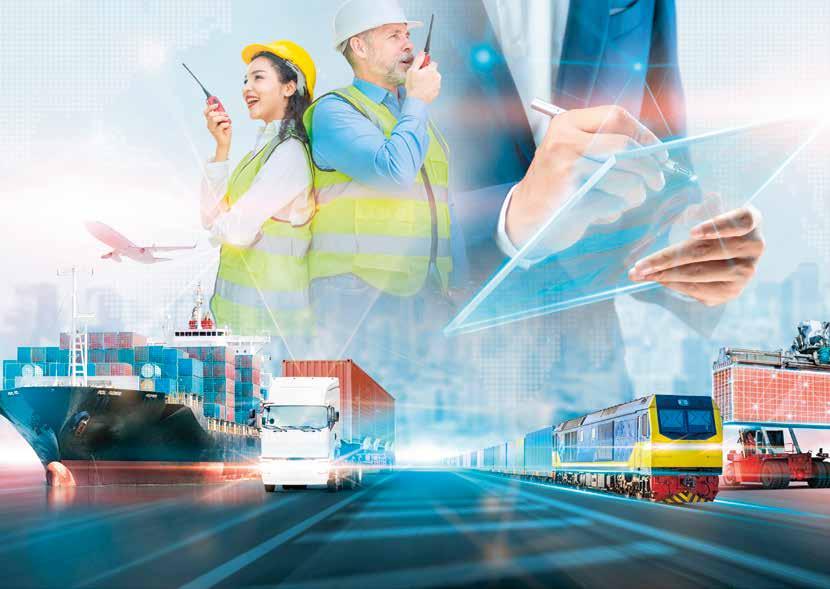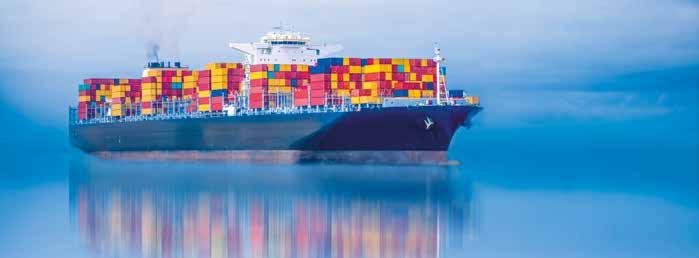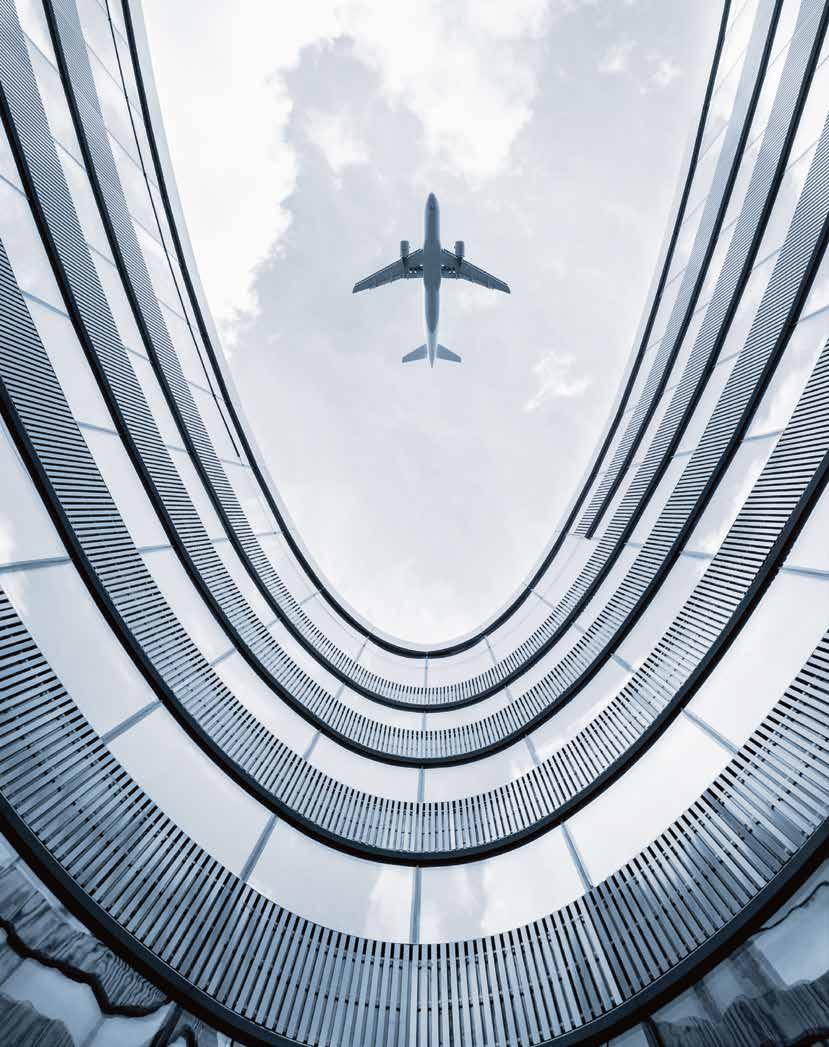THE WORLD IN MOTION



Transport connections, primarily freight transport links and logistics, are among Serbia’s key advantages, given the country’s strategic position on Corridor 10. However, additional efforts are required to build the infrastructure that would enable those advantages to be fully utilised
The future of transport and logistics is dependent on the continued digitalisation, automation and optimisation of processes, the increased application of robots and artificial intelligence, the deployment of drones and the mass use of electric delivery vehicles, including heavy haulage trucks

Living and working is easy in times of peace. The challenges come during times of turmoil that require continuous adap-
tation. It is then that long-term solutions that have remained unchanged for decades lose their value, particularly in areas of life and business that are strongly influenced by geopolitical happenings. And transport and logistics certainly fall into that category...
It was initially the pandemic – with its varied and numerous restrictions, but also large numbers of people infected with the Covid-19 virus – that desta-
bilised movements of people and goods, and threatened supply chains, but fortunately didn’t cause them to break. Despite it seeming impossible for the situation to deteriorate further, with the end of the pandemic came even greater challenges to confront the transport and logistics sector – with the war in Ukraine, the energy crisis, rising inflation, driver shortages – which no country was protected against, including Serbia.
Testifying to the idea that Serbia can overcome the global crisis and find itself on the right track just by cooperating with European countries and exchanging experiences is the decision to choose Belgrade as the location for the headquarters of the Permanent Secretariat of the Transport Community, representing an international
organisation founded with the aim of further developing the existing transport network connecting the EU and the countries of Southeast Europe. The Transport Community’s members include the European Union and the six countries of the Western Balkans: Albania, Bosnia-Herzegovina, North Macedonia, Kosovo, Montenegro and Serbia, while its purpose is to extend the EU transport market’s rules, principles and policies to the countries of the Western Balkans through a legally binding framework. The agreement is applied in the areas of transport by road, rail, inland waterways and maritime routes, and Serbia has obliged itself, with the adopting of the founding agreement, to harmonise its legislation with the EU acquis in these areas. Serbia attaches great importance to every project agreed and implemented in partnership with this international organisation, which has also been the case with the joint project of Slovenia, Serbia, Croatia, Austria, and probably also Italy, to develop a single rail route that would connect Belgrade, Zagreb and Ljubljana with Vienna and northern Italy, but also with talks on the inclusion of North Macedonia, Greece and Turkey in regional infrastructure projects following completion of the Belgrade-Niš high-speed railway.
In order for Serbia to take advantage of the strategic regional position that it enjoys thanks to geography, it is essential to finalise many infrastructure works, including the launched construction of roads and highways, as well as the railway to Hungary; to introduce more efficient customs procedures, accelerate digital transformation processes and implement numerous other measures that will contribute to short-
ening goods transport times. New investments could secure, among other things, incomparably more efficient transit conditions for goods being transported from China to Europe, as well as improving Serbia’s positioning on the map of Europe.
Construction of the Belgrade-Niš highspeed railway is just one of the major investments in rail infrastructure that are long overdue. Freight transport by rail currently accounts for approximately 18 per cent of total goods transports, which is below the expected level, but is nonetheless commensurate with the current state of rail infrastructure, which is on the whole very poor, with low transit options of domestic rail routes. According to the expectations of transport experts, railways could achieve 25 per cent participation in freight transport flows over the next five years, increasing to 35 per cent over the next decade. The expansion of “dry ports”, built at intersections between important rail and road routes, would certainly contribute to achieving this goal.

One of the Serbian Government’s strategic plans is to connect the Danube and Sava rivers to the rail and road routes of Pan-European Corridor 10. Considering that the problems hindering river and port transport haven’t been solved for years, estimates suggest that a minimum of 500 million euros needs to be invested in waterways infrastructure, but there’s no doubt
that the existing picture will improve with the construction of a new port in Belgrade and investments in the port of Novi Sad and to increase the capacities of the ports of Prahovo, Bogojevo and Smederevo.
Advancing rail infrastructure will undoubtedly lead to an increased reliance on rail transport, especially if it is accompanied by the entry of private operators and additional investments in intermodal terminals. This would lead to large quantities of goods being transferred from trucks to trains, but also to the development of combined transport that fuses road and rail and is considered the future of the sector.
Providing an additional reason to switch from road transport to rail is the fact that road haulage operations currently account for a quarter of all greenhouse gas emissions in the European Union and that pollution is a huge problem in the countries of the Western Balkans.
Apart from developing sustainable operations and reducing CO2 emissions, the future of transport and logistics includes the further digitalisation, automation and optimisation of processes, the increased application of robots and artificial intelligence, the deployment of drones and the mass use of electric delivery vehicles, including heavy haulage trucks. Demonstrating that this is neither some distant future reality nor pie in the sky is the current scene on U.S. interstate highways, where AI-controlled trucks already cruise.
Europe is now trying to catch up, and its success will mean smart, autonomous trucks also arriving in our region.
CONSTRUCTING ROAD AND RAIL INFRASTRUCTURE IS CRUCIAL TO STRENGTHENING THE ECONOMIES AND COMPETITIVENESS OF THE ENTIRE REGIONDirector,
At Translucent Logistics they are extremely proud that the company has offered a comprehensive range of logistics solutions since its inception, with a deep understanding of the key business challenges confronting the transport and logistics sector

The Translucent Logistics team is deeply committed to solving the key challenges of sustainability, digitalisation and workforce availability, which they view as opportunities to innovate and advance, in the belief that this will help the company offer clients logistics solutions that are even more customised and sustainable.
continuously innovating our services, maintaining a presence in key regions and offering logistics solutions at a global level, as well as transparency, sustainability and the continuous improvement of services.
Are you satisfied with your results and current market position?
—Our first year of operations really presented us with a unique series of challenges, including a major energy crisis and the continuing conflict in Ukraine. We have attempted to turn
ents’ demands. Our commitment to tailoring our services is driven by our understanding that every client and every shipment is unique.
What are the key issues for the transport and logistics industry; and how much attention do you devote to those issues?
What kind of initial vision and strategy did you have when launching the business?
—When we embarked on our journey in the logistics sector, we envisaged a business that would not only offer a wide range of universal logistics solutions, but that would also address the key challenges confronting the enterprises operating in this industry. Our vision from the outset was for us to become a reliable partner to companies seeking to optimise operations along their supply chain and advance the overall efficiency of their logistics.
Our strategy is built on foundations of several key principles, which include being client-oriented, accepting the latest technology and
this adversity into an opportunity, and such an approach has contributed to securing our position on the global market. We are satisfied with the progress we’ve achieved, given that we’ve succeeded in establishing a strong presence in the logistics sector, serving an ever-increasing number of clients with various needs.
In the dynamic world of logistics, it is vital to monitor and keep pace with global trends that encompass, among other elements, technological advances, amendments to trade regulations, changes in consumer preferences and new sustainability practices. We adapt our services proactively to ensure that they are aligned with industry best practices and that we can anticipate our cli-
—Sustainability, digitalisation and workforce availability are key issues in the transport and logistics industry, and they don’t only shape the present situation, but also have a significant impact on the future of our business. We recognise the logistics sector’s environmental impact and actively seek ways to reduce it. This includes adopting environmentally friendly transport methods, optimising routes for efficiency and investing in technologies that minimise our carbon footprint.
We see digitalisation as the driving force that will enable us to continue simplifying processes and reducing costs, and that will allow us to provide even more customised logistics solutions in the future. We are fully aware that artificial intelligence and advanced digitalisation will play a key role in the future of logistics, because AI-driven algorithms are able to optimise supply chains, predict demand and improve route planning. The availability of skilled labour is vital to our industry. We invest in training and development programmes in order to nurture talented individuals in our organisation.
WE ADAPT OUR SERVICES PROACTIVELY TO ENSURE THAT THEY ARE ALIGNED WITH INDUSTRY BEST PRACTICES AND THAT WE CAN ANTICIPATE OUR CLIENTS’ DEMANDS

For (inland) goods transportation, 2023 is a year of stagnating tonnage and some segments will show declines. On the passenger side, however, it’s the opposite. The pace of recovery is exceeding expectations since travel has opened up post-lockdowns and restrictions. As consumers continue to prioritise travel, the double-digit rebound of aviation is helping to push growth in the global transport and logistics sector to 4%, exceeding global GDP growth. After the unprecedented drop in 2020, the sector will exceed its pre-pandemic level by the end of the year.
After digesting the initial ‘after shocks’, the global economic slowdown will have a stronger impact in 2024, leading to a more challenging year for most of the sector.
For public transport volume, 2023 is a year of continued recovery as well. Rail figures in European countries were still significantly below pre-pandemic levels in 2022. Full recovery won’t be reached in 2023, but figures are trending up and weekends are relatively busy.
On the goods side, recent stretched and vulnerable supply is helping transport and logistics companies navigate their way through a phase of lower demand. With shortages fresh in mind, companies in road transport have managed to pass on higher costs fairly well despite a sluggish market. In container shipping and logistics, locked-in higher rates – accounting for more than half of the volume – will expire in batches over 2023, leading to falling profits into 2024.
The pandemic extremes are gradually fading in transport and logistics, but normalisation comes with after-shocks and sanctions are shaking up trade routes. So what does the year ahead have in store for shipping, container shipping and aviation?


Global supply chains continue to stabilise in 2023, and much of the congestion in shipping and port capacity has been solved. But it will also take time to fully digest the effects of the pandemic and war-related supply shocks. Lead times of airfreight and containerised seafreight are still longer compared to pre-pandemic standards and arrival performance rates still have upward potential. In the highly regulated aviation sector, spare part supply is an ongoing constraint and consequently aircraft manufacturers are limited in ramping up production.
Commodity trade patterns have adjusted to sanctions on Russia. This is most
shortages are a reason for this, and an increase in climate change-related (extreme) weather events also pose a larger disruption risk. The restrictive low water levels on the Panama Canal – a crucial link on the Asia-U.S. East Coast trade – are a recent example, and the return of El Nino could also lead to extreme weather going forward.
Supply chain resilience remains more important for shippers in the post-pandemic world, and contract logistics can benefit from that. Shippers seem to be sticking to higher buffer stocks to increase supply chain resilience. With the lessons learned from the pandemic, supply chain management (and risks) are still high on the agenda. Logistics services are structurally more profitable than A to B transportation.
Before the pandemic, the total transport sector accounted for a fifth of global CO2 emissions, with road traffic making up three-quarters of it. From an economic and business perspective, CO2 emission development is increasingly important. CO2 emissions have their price and this will gradually be incorporated into
While the extremes of the Covid-19 pandemic supply shock have faded, the sector is still witnessing the ripple effects of normalisation in consumer behaviour and prolonged capacity issues. At the same time, the economy is slowing and industrial production is slumping. The supply shock from the pandemic and the impact of the war in Ukraine have also left their mark on various parts of the transport and logistics sector. Either long because of excess capacity after a historic boom (in container shipping) or short because of lagging deliveries of aircraft and capacity-absorbing rerouting because of sanctions (in shipping).
While consumer goods logistics is facing a correction, there is a sunnier outlook for aviation which is benefiting from pentup travel demand, while public transport is also becoming busier again.
visible in energy commodities trade to Europe and more indirect trade flows. On balance, this leads to reshaped routes, less efficient trade and more sea miles –which benefits tanker shipping.
The U.S. is attempting to ramp up regional production to move away from its dependence on China, increased with digitalisation and the shift to green technologies like electric vehicles. This is a long-term process. So far, we don’t see massive deglobalisation, but rather diversification. In Europe, the Supply Chain Due Diligence Act could impact sourcing routes.
Supply chain uncertainty probably remains higher. Structural labour market
business models, since shippers and operators are increasingly pushing for progress with regulatory pressure, sustainability reporting obligations and corporate ambitions. The European emissions trading system (ETS) is already introducing carbon pricing for aviation and shipping.

CO2 emissions in transport (also including autos) dropped by more than 16% during the pandemic, with falling road traffic and the collapse of airline traffic. With combustion engines returning in larger quantities on motorways in 2021 and more aircraft returning to the skies in 2022, CO2 emissions returned to 96.5% of pre-pandemic levels last year.
Given the progress in electrification within the global car fleet (in 2020, 1% of the global stock was electric, rising to 2.5% in 2022, including plug-in hybrids), but also efficiency efforts in trucking, aviation and shipping, transport CO2 emissions are expected to continue to rise at a lower level than demand. This means the average carbon intensity of transport activity will decrease.
Electrification of the global car fleet continues, and in aviation the strong rebound in passenger numbers is likely to offset gains made by using more sustainable aviation fuels. The International Energy Agency expects oil consumption of transport to start declining after 2026.
THE TRANSPORT AND LOGISTICS SECTOR WILL SEE 3% GROWTH IN 2024

“People who want to understand democracy should spend less time in the library with Aristotle and more time on the buses and in the subway”
Simeon Strunsky